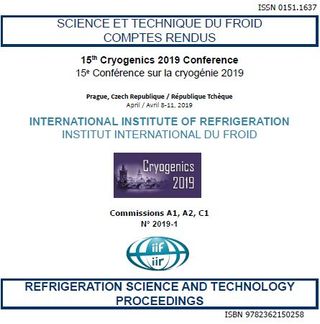?
The enhancement of the critical temperature in thin aluminium films
P. 363–368.
Седов Е. А., Голоколенов И. А., Konstantinidis G., Stavrinidis A., Stavrinidis G., Завьялов В. В., Арутюнов К. Ю.
В книге

Vol. 15. , P.: IIF-IIR, 2019.
Ивашенцева И. В., Каурова Н. С., Воронов Б. М. и др., St. Petersburg Polytechnical University Journal: Physics and Mathematics 2025 Vol. 18 No. 3.2 P. 129–133
Сверхпроводящие пленки NbN, изготовленные методом реактивного магнетронного распыления, являются чувствительным элементом болометров на эффекте © Ivashentseva I.V., Kaurova N.S., Voronov B.M., Goltsman G.N., Tretyakov I.V., 2025. Published by Peter the Great St. Petersburg Polytechnic University. 129 St. Petersburg Polytechnic University Journal. Physics and Mathematics. 2025. Vol. 18. No. 3.2 электронного разогрева HEB. Основной принцип HEB ...
Добавлено: 24 декабря 2025 г.
Третьяков И. В., Каурова Н. С., Ивашенцева И. В. и др., Журнал технической физики 2025 Т. 94 № 7 С. 1102–1110
Экспериментально исследовано влияние параметров процесса магнетронного осаждения тонкой 4–5 nm сверхпроводящей пленки нитрида ниобия NbN и технологии изготовления NbN HEB-смесителей на разброс их основных параметров для минимизации в дальнейшем этого разброса. Однородность параметров изготовленных NbN HEB-смесителей, кроме оптимизации процесса осаждения NbN-пленки, достигалась за счет подготовки поверхности Si-подложки, а также за счет использования осажденного in situ с пленкой ...
Добавлено: 23 декабря 2025 г.
Khudchenko A., Turygin S., Golubev E. и др., Proceedings of SPIE 2025 Vol. 13102 P. 858–862
Космическая обсерватория «Миллиметрон» будет оснащена криогенно охлаждаемым прибором для интерферометрии со сверхбольшими базами «космос-земля» (S-E VLBI). Это будет многоканальный гетеродинный приемник с каналами 7 мм, 3 мм, 1,3 мм и 0,8 мм. Прибор VLBI будет обладать многочастотными возможностями, обеспечиваемыми разделением сигнала во входной оптике и функциями обработки данных на заключительном этапе. Оптическая схема представлена в ...
Добавлено: 23 декабря 2025 г.
Третьяков И. В., Худченко А. В., Рудаков К. И. и др., IEEE Transactions on Terahertz Science and Technology 2024 Vol. 15 No. 2 P. 191–199
Изучение происхождения и переноса воды во Вселенной является важной частью научной программы космической обсерватории «Миллиметрон». Это станет возможным благодаря наблюдениям, проводимым в режиме одноантенного телескопа с использованием бортового прибора — спектрометра высокого разрешения (HRS). Этот прибор включает в себя гетеродинные приемники, работающие в диапазоне 0,5–2,7 ТГц, состоящие из 3-пиксельных матриц сверхпроводниково-изоляторно-сверхпроводниковых смесителей, работающих на частотах ...
Добавлено: 23 декабря 2025 г.
Kamashev A. A., Garif’yanov N. N., Validov A. A. и др., Physical Review B: Condensed Matter and Materials Physics 2025 Vol. 112 No. 13 Article 134509
Добавлено: 20 декабря 2025 г.
M. Yu. Kagan, A. V. Krasavin, R. Sh. Ikhsanov и др., Journal of Superconductivity and Novel Magnetism 2025 Vol. 38 Article 246
Добавлено: 25 ноября 2025 г.
Семенов А. Г., Latyshev A., Andrei D. Zaikin, Physical Review B: Condensed Matter and Materials Physics 2025 Vol. 112 No. 14 Article 144501
Добавлено: 14 ноября 2025 г.
M. V. Parfenov, I. S. Burmistrov, Physical Review B: Condensed Matter and Materials Physics 2025 Vol. 112 No. 16 Article 161407
Добавлено: 9 ноября 2025 г.
Банников М. И., Селиванов Ю. Г., Мартовицкий В. П. и др., Письма в Журнал экспериментальной и теоретической физики 2025 Т. 122 № 4 С. 220–226
В данной работе исследуется легирование железом классического нематического сверхпроводника SrxBi2Se3. Установлено, что при атомной доле Fe меньших концентрациях железа критическая температура сверхпроводимости и анизотропия нематической сверхпроводимости не изменяются. Измерения намагниченности подтверждают связанный с Fe парамагнетизм. Кристаллическая структура (параметр решетки c) и транспортные свойства плавно меняются при ко-допировании Fe, что указывает на равномерное внедрение Fe в ...
Добавлено: 9 ноября 2025 г.
Kalashnikov D., Seleznev G., Kudriashov A. и др., Physical Review B: Condensed Matter and Materials Physics 2025 Vol. 112 No. 14 Article 144504
Добавлено: 9 ноября 2025 г.
Shpagina E. V., Тихонов Е. С., Ruhstorfer D. и др., Physical Review B: Condensed Matter and Materials Physics 2025 Vol. 112 No. 14 Article L140503
Добавлено: 9 ноября 2025 г.
Солдатенкова М. Д., Ломакин А. И., Святодух С. С. и др., Журнал технической физики 2025 Т. 95 № 9 С. 1836–1842
овые области применения сверхпроводниковых однофотонных детекторов повышают требования к большой активной площади детекторов. Разработан дизайн и изготовлен 12-пиксельный NbN-детектор с большой активной областью и с шириной полоски 500 nm и размером активной площади 45 ×× 50 μμm, что подходит для согласования с многомодовым оптоволокном. Исследованы вольт-амперные характеристики и определен критический ток образца IcIc. Это значение было сопоставлено с максимально ...
Добавлено: 29 октября 2025 г.
Таркаева Е. В., Иевлева В. А., Кунцевич А. Ю. и др., Journal of Applied Physics 2025 Vol. 138 No. 12 Article 123904
Добавлено: 5 октября 2025 г.
Милютин Д. П., Пугач Н. Г., В кн.: ТЕЗИСЫ IV Международной конференции «Физика конденсированных состояний» ФКС-2025.: Черноголовка: [б.и.], 2025. С. 111–111.
Сверхпроводниковый эффект близости представляет особый интерес для изучения из-за возможности широкого применения в квантовых технологиях. Гетероструктура сверхпроводник-изолятор-нормальный металл (NIS) стала популярной для изучения сверхнизких температур, благодаря эффекту, схожем с эффектом Пельтье.
Теоретически было показано, что возможно достичь температуры 50 мК, стартуя с 300
мК. Однако, эффективному охлаждению мешает подщелевой ток, возникающий в
результате, андреевского отражения. Лучший способ для его ...
Добавлено: 6 сентября 2025 г.